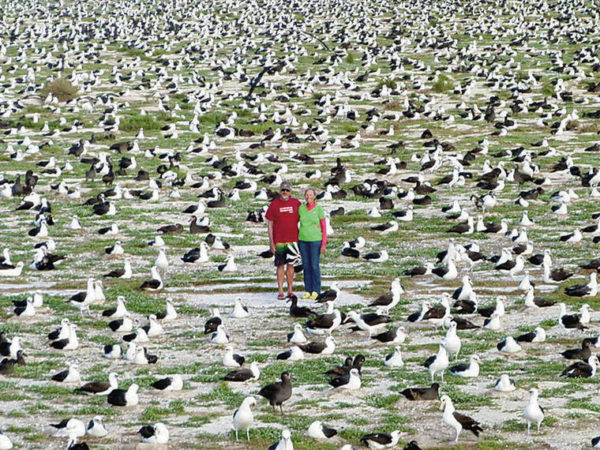Published in the Ocean Watch column, Honolulu Star-Advertiser © Susan Scott
December 28, 2019
MIDWAY ATOLL >> While walking on an Oahu beach earlier this month, a stranger, seeing my T-shirt that says “MIDWAY IS FOR THE BIRDS,” asked if I had been to Midway. When I said yes, and was going again soon, he astonished me by saying, “Why do you go there? I heard all the birds were dead.”
Given all the bad news we hear about the world’s dwindling wildlife, I understand why the man thought that. But it’s wrong. I’m here to help count a million albatrosses.
 Some birds die with plastic in their stomachs, and those sad photos stick in the mind.
Some birds die with plastic in their stomachs, and those sad photos stick in the mind.
But when the subject of Midway comes up, remember instead this photo
of me (Susan Scott), Craig and some of our million or so albatross friends.
Courtesy Martha Brown
Since 1996 teams of U.S. Fish and Wildlife volunteers have annually counted around 500,000, give or take 100,000, albatrosses sitting on eggs on Midway Atoll’s three islands, totaling just under 3 square miles. This yearly head count shows that the albatross population here is relatively stable.
Each sitting bird represents a mated pair, since the male and female take turns keeping their one egg warm. One babysits while the other is out feeding.
It starts in November when the two arrive separately from sea to meet at their chosen nest site, the same spot year after year. In a touching reunion the two murmur, cuddle and groom one another’s head and neck. Romance doesn’t last long, though, because the two have a long, hard job to do. Hatching an egg and raising the chick takes about seven months.
About 10 days after copulation, the female lays her fertilized egg. This energy-intensive chore means that she must soon fly off to find food, leaving her mate to tend their egg.
And tend it he does, turning it, talking to it and clapping his bills at intruders. Depending on his mate’s fishing luck, the male’s first turn at egg sitting can last over three weeks. The changing of the guard is another tender scene, where the two seem to discuss the situation.
Sitting birds are mostly still, moving only to clap their beaks, drink rain as it falls or lean over the sides of their ground nests to make repairs. But this albatross colony is far from quiet. Surrounding the prospective parents are hundreds of thousands of unmated birds singing and dancing up a storm as they look for mates.
We can’t count these roaming walkers, but their boisterous partying is a joy to behold.
The singing, dancing albatrosses are mostly 3- to 9-year-olds searching for their first partners, but some are birds whose mates did not return. For instance, the famous 69-year-old female named Wisdom has had three mates over her long life.
We are so bombarded with heart-breaking news about the world’s wildlife that it’s hard to remember that success stories exist. Hawaii’s albatrosses, and the people who care for them, are one such positive story.
Why do I volunteer to work here? I do it for the birds.